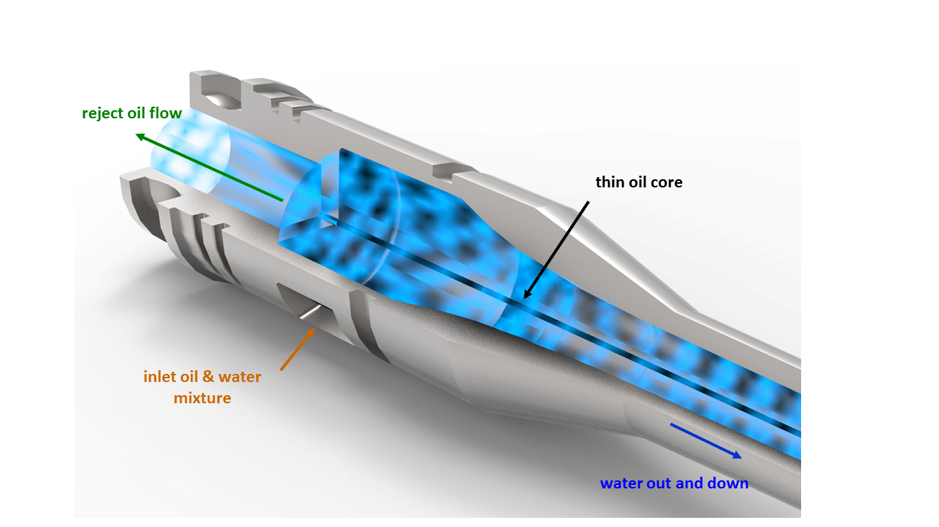Produced Water Treatment with Deoiling Hydrocyclones – Misconceptions & Corrections (B-PWT007)
How Deoiling Hydrocyclones Work
Deoiler hydrocyclones only operate effectively with the correct pressure differential(s). The oil-water mixture is fed tangentially into the Deoiler liner through the inlet slot(s). The inlet velocity and inlet shape force the oil-water mixture to spin in a vortex flow pattern. Rotational acceleration increases as the internal diameter is reduced over the length of the liner. Centrifugal forces generated by the flow pattern create the separation between the two immiscible liquids (oil and water). The heavier water is forced outward toward the inner wall of the liner, which displaces the lighter oil that migrates to the centre of the liner, where it forms a thin oil core.
The heavier water flows out down through the tailpipe creating the underflow stream. By controlling the pressure differentials across the liner, the light phase oil is forced to flow in the opposite direction to create the “core”. The oil core is forced to flow through a centred top opening creating the overflow or reject stream. The result is a simple, but effective, separator with a 2-3 second residence time and no moving parts.

It is important to emphasis here that to keep the separation efficiency at the highest level in a hydrocyclone – any hydrocyclone – the reject stream must be maintained at or above a set percentage of the inlet water being treated. The tougher the water treatment application, the higher this reject rate.
Typical reject rates for Deoilers range from 3 – 8%. Think of the reject rate as the same as the skimming or oil removal rate of a simple oil-water separation tank.
The ‘toughness’ of a water treatment application is defined by the size of the oil droplets in an oil-in-water emulsion;
- 40 microns is considered easy ] primary separation
- 20 microns is considered tough ] secondary separation
- 10 microns is considered demanding ] secondary / tertiary separation
Emulsions may be additionally tough due to the stabilising effect of chemicals in the water. These chemicals may be introduced (i.e. corrosion inhibitors, scale inhibitors, forward demulsifiers, etc.) or may be naturally occurring in the oil & gas system. In these cases additional chemicals (e.g. reverse demulsifier) are needed to break the emulsion.
Getting back to reject rates – to achieve the required reject flow rate, a pressure profile across the Deoiler liner must be set up and maintained to ensure the reject ‘flows’ at the acceptable rate.
This pressure profile or Pressure Differential Ratio (PDR) is defined as;
Descriptively; the PDR is the inlet pressure minus the reject pressure divided by the inlet pressure minus the outlet (water) pressure.
A PDR at 1.8 – which is used a starting point in the design basis of an eProcess Deoiler hydrocyclone – equates to a reject rate of around 3-5%, which is acceptable for normal to easy applications.
Tough applications require a higher reject rate of 5-8% to achieve suitable performance, which equates to a PDR of 2.0 or above.
A Deoiler hydrocyclone system with inadequate PDR is one of the most common preventable faults in the operation of a produced water treatment system.
